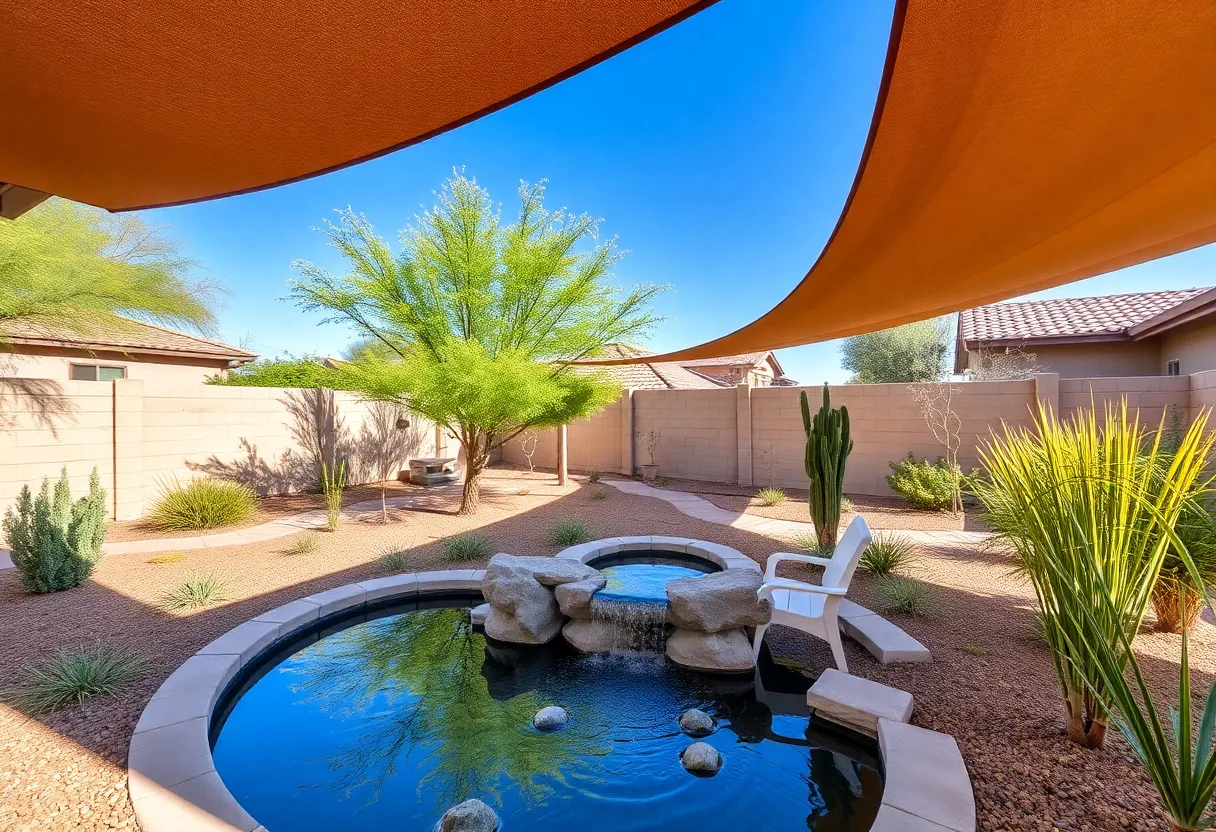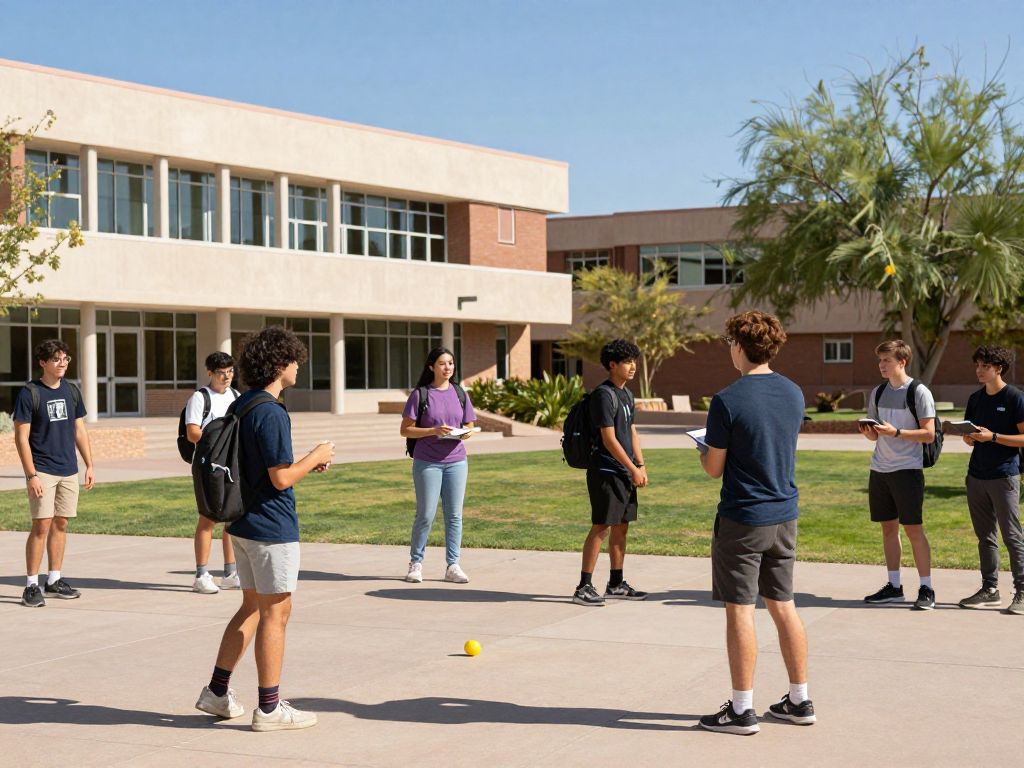10 Easy Steps to Design a Gorgeous Backyard Oasis in Phoenix’s Heat
Creating a backyard oasis in Phoenix’s intense heat demands meticulous planning and design strategies. The goal is to craft a space that is not only visually appealing but also comfortable and functional under extreme temperatures. By integrating various heat-resistant elements, providing ample shade, introducing water features, and selecting appropriate plant life, you can transform a plain yard into a serene retreat. Below are ten essential steps, backed by practical insights, to achieve this transformation.
1. Choose Heat-Resistant Materials
The foundation of any durable outdoor space starts with selecting the right materials. In a desert climate, materials need to withstand high temperatures without degrading or becoming uncomfortable to walk on.
Light-colored and reflective surfaces are vital because they reduce heat absorption. For example, travertine and limestone are natural stones that remain cooler than dark concrete or asphalt. These materials should be used for patios, walkways, and pool decks to enhance comfort and minimize surface heat.
Durability also involves selecting weather-resistant furniture and fixtures. Materials like resin wicker, treated metal, and synthetic wicker are designed for outdoor conditions and retain their appearance over time. Using heat-resistant coatings on furniture or fixtures can prevent premature deterioration due to sun exposure.
2. Incorporate Shade Structures
Providing adequate shade is fundamental in reducing direct sun exposure, which can reach surface temperatures of over 150°F in Phoenix.
Shade structures such as pergolas, shade sails, or retractable awnings serve dual purposes: protecting from the sun and adding architectural appeal. Position these structures strategically over seating areas, dining zones, or outdoor kitchens to maximize comfort.
Using pergolas with climbing plants or fabric shade sails with UV protection can increase shaded area while enhancing aesthetic appeal. Install adjustable awnings for flexibility, allowing you to modify shade levels throughout the day.
3. Install Misting Systems
Misting systems are a highly effective cooling method. They work by releasing fine water droplets into the air, which evaporate quickly, thereby lowering ambient temperature by up to 30°F.
Strategically placed misting nozzles along pergolas, patio edges, or outdoor dining areas create a refreshing microclimate. Use high-pressure misting systems that conserve water through recirculation and precise nozzle control.
For best results, combine misting with shade structures and outdoor fans to create a cools microenvironment suitable for hot summer days. Proper installation is key to prevent over-wetting and ensure durability.
4. Select Drought-Tolerant Plants
Achieving a lush look in Phoenix while conserving water requires choosing drought-tolerant plants. Native Arizona flora such as succulents, cacti, agave, and yucca are adapted to survive with minimal water and resist high temperatures.
Group plants with similar watering needs to simplify maintenance and maximize water efficiency. Use mulching around plant beds to reduce evaporation. Incorporate native grasses and perennial flowers for color and texture.
Design Plant beds with plants placed in strategic zones, considering sun exposure and wind patterns. Opt for drought-tolerant ground covers to prevent soil erosion and enhance aesthetics.
5. Add Water Features
Water features are not only visually appealing but also bring a cooling factor to the environment. Small fountains, ponds, or recirculating pools add tranquility and attract local wildlife.
For water conservation, choose recirculating systems that reuse water efficiently. Incorporate features like bubbling rocks or stream beds that blend naturally with the landscape.
Ensure the water features are properly shaded or placed in cooler zones to prevent excessive evaporation. The sound of running water provides a serene atmosphere that complements the overall oasis feel.
6. Utilize Outdoor Fans
Outdoor-rated fans are invaluable for air circulation and reducing perceived heat. Install ceiling fans under pergolas or shade sail structures, and position standalone fans in open areas.
Fans work best when combined with shade and misting for maximum cooling efficiency. Make sure fans are designed for outdoor use with rust-resistant components. Proper placement ensures airflow distribution covers seating and dining zones effectively.
Using fans not only enhances comfort but also deters insects, improving overall outdoor experience during warm evenings.
7. Implement Smart Irrigation Systems
Efficient watering practices are critical in arid climates. Smart irrigation systems use weather data and soil moisture sensors to adjust watering schedules, preventing overwatering and conserving valuable water resources.
Drip irrigation systems deliver water directly to the roots, reducing evaporation loss. Automated systems with timer controls ensure consistent hydration, while zone-specific programming accommodates different plant needs.
Regular maintenance and system checks are essential to prevent clogging and optimize performance. These systems minimize water waste and promote healthy plant growth.
8. Create Defined Outdoor Living Spaces
Designate distinct zones for relaxation, dining, and entertaining. Use weather-resistant furniture and durable outdoor rugs to define each area. Incorporate fire pits or outdoor fireplaces to extend usability into cooler evenings.
Intimate seating arrangements around fire elements promote gatherings and social interactions. Use modular furniture for flexibility and decorative lighting to enhance ambiance.
A well-organized layout ensures efficient flow and maximized comfort, making your yard a true outdoor sanctuary.
9. Incorporate Hardscaping Elements
Hardscaping adds structure to your landscape. Use solar-reflective paving, concrete, or natural stone for paths, patios, and seat walls.
Materials should compliment the desert environment—think earth-toned and textured surfaces. Hardscaping provides functional hard points that reduce the need for constant lawn maintenance and watering.
Implement raised beds or retaining walls to define garden zones and incorporate seating areas alongside benches or strategic planters.
10. Plan for Privacy
A private backyard fosters relaxation and privacy from neighbors or passersby. Use native shrubs, bamboo screens, or climbing plants on trellises to create natural barriers.
Decorative screens and privacy panels can be positioned to block unwanted views while adding visual interest. Selecting evergreen or dense foliage ensures year-round seclusion.
Designing privacy zones alongside seating areas boosts seclusion and tranquility, completing your resort-style backyard.
Frequently Asked Questions (FAQ)
Q1: How can I keep my backyard cool during Phoenix’s summer?
Utilize shade structures, misting systems, outdoor fans, and drought-tolerant plants. Combining these elements significantly reduces surface and ambient temperatures, creating a comfortable space.
Q2: Are drought-tolerant plants sufficient for a lush backyard in Phoenix?
Yes. Native succulents, cacti, and desert-adapted shrubs thrive with minimal water while providing vibrant color and texture. Proper placement and grouping according to water needs optimize their growth.
Q3: What are the best materials for surfaces in Phoenix’s climate?
Light-colored, reflective stones like travertine and limestone stay cooler underfoot. Avoid dark asphalt or concrete, which absorb and retain heat.
Q4: How can I incorporate water features without excessive water use?
Use recirculating systems with solar power if possible, and select small, naturalistic features that blend into the landscape. Proper placement and shading help minimize evaporation.
Q5: How important is privacy in a backyard oasis?
Providing privacy enhances the secluded feeling and relaxation. Use native shrubs, trellises with climbing plants, and privacy screens to define your space.
JSON-LD Structured Data for FAQ
Key Features Comparison Chart
| Feature | Importance | Recommended Options |
|---|---|---|
| Material Selection | High | Travertine, limestone, light-colored concrete |
| Shade Structures | High | Pergolas, shade sails, retractable awnings |
| Cooling Systems | High | Misting systems, outdoor fans |
| Plant Choices | High | Succulents, cacti, native grasses |
| Water Features | Medium | Recirculating fountains, small pools |
| Hardscaping | Medium | Paved patios, seating walls |
| Privacy Elements | High | Native shrubs, trellises, privacy screens |
Author: STAFF HERE PHOENIX WRITER
The PHOENIX STAFF WRITER represents the experienced team at HEREPhoenix.com, your go-to source for actionable local news and information in Phoenix, Maricopa County, and beyond. Specializing in "news you can use," we cover essential topics like product reviews for personal and business needs, local business directories, politics, real estate trends, neighborhood insights, and state news affecting the area—with deep expertise drawn from years of dedicated reporting and strong community input, including local press releases and business updates. We deliver top reporting on high-value events such as the Waste Management Phoenix Open, Cactus League Spring Training, and Arizona State Fair. Our coverage extends to key organizations like the Greater Phoenix Chamber of Commerce and Visit Phoenix, plus leading businesses in technology and healthcare that power the local economy such as Intel and Banner Health. As part of the broader HERE network, including HERETucson.com, we provide comprehensive, credible insights into Arizona's dynamic landscape.





